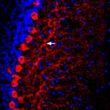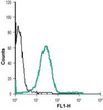Ptger2 Rabbit Polyclonal Antibody
Frequently bought together (1)
beta Actin Mouse Monoclonal Antibody, Clone OTI1, Loading Control
USD 200.00
Other products for "Ptger2"
Specifications
| Product Data | |
| Applications | FC, IHC, WB |
| Recommended Dilution | WB: 1:200-1:2000; IHC: 1:100-1:3,000; FC: 1:50-1:600 |
| Reactivities | Human, Mouse, Rat |
| Host | Rabbit |
| Clonality | Polyclonal |
| Immunogen | Peptide (C)DETSSRKEKWDLR, corresponding to amino acid residues 287-299 of rat prostanoid EP2 receptor . 3rd extracellular loop. |
| Formulation | Lyophilized. Concentration before lyophilization ~0.8mg/ml (lot dependent, please refer to CoA along with shipment for actual concentration). Buffer before lyophilization: phosphate buffered saline (PBS), pH 7.4, 1% BSA, 0.05% NaN3. |
| Reconstitution Method | Add 50 ul double distilled water (DDW) to the lyophilized powder. |
| Purification | Affinity purified on immobilized antigen. |
| Conjugation | Unconjugated |
| Storage | Store at -20°C as received. |
| Stability | Stable for 12 months from date of receipt. |
| Gene Name | prostaglandin E receptor 2 (subtype EP2) |
| Database Link | |
| Background | Prostaglandin E2 (PGE2) is involved in a number of physiological and pathophysiological events in many tissues throughout the body. The physiological actions of PGE2 are mediated through its interaction with cell surface prostaglandin E receptors. There are three pharmacologically defined subtypes of the EP receptor, EP1, EP2, and EP3, and these subtypes are suggested to be different in their signal transduction. These receptors belong to the G-protein coupled receptor (GPCR) superfamily. Like all members they have seven transmembrane domains with extracellular N-terminal tail and intracellular C-terminus. The EP2 receptor is expressed in the vasculature, the gastrointestinal tract, kidney and also in the ciliary muscles in the eye. PGE2 is known to play a central role in the pathophysiology of inflammation in synergy with other proinflammatory mediators. PGE2 inhibits the function and the proliferation of T cells and the histamine release from mast cells by increasing the intracellular level of cAMP. EP2 subtype is thought to be in part responsible for vasodilation, oedema formation, hyperanalgesia, modulation of the immune system, and the breakdown of bone and cartilage associated with disorders such as rheumatoid arthritis. |
| Synonyms | EP2 |
| Reference Data | |
Documents
| Product Manuals |
| FAQs |
| SDS |
{0} Product Review(s)
0 Product Review(s)
Submit review
Be the first one to submit a review
Product Citations
*Delivery time may vary from web posted schedule. Occasional delays may occur due to unforeseen
complexities in the preparation of your product. International customers may expect an additional 1-2 weeks
in shipping.






























































































































































































































































 Germany
Germany
 Japan
Japan
 United Kingdom
United Kingdom
 China
China






